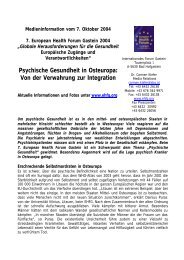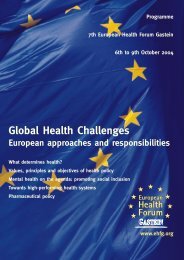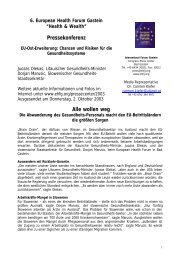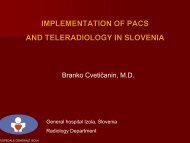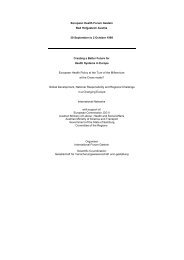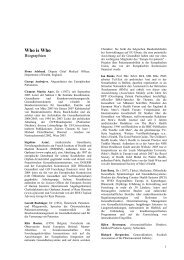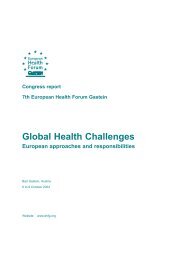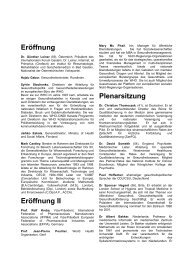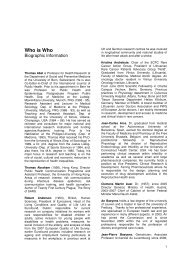Congress report - European Health Forum Gastein
Congress report - European Health Forum Gastein
Congress report - European Health Forum Gastein
You also want an ePaper? Increase the reach of your titles
YUMPU automatically turns print PDFs into web optimized ePapers that Google loves.
<strong>Forum</strong> I: <strong>Health</strong> in other Policies and Sectors<br />
Session 3: Measuring progress and impact<br />
This concerned a description of the WHO supported Verona initiative (4), both in the<br />
eponymous region of Italy and adapted in the context of Slovenia, that attempts to take<br />
account of the economic, social and human environment. Verona is a province of 250,000<br />
people in the North east of Italy. Luigi Bertinato indicated that here had not previously been<br />
a tradition of inter-action between the health sector and others. An objective of the project<br />
was to create an arena of debate between various sectors and to compare and discuss<br />
experience of various health issues. It was intended to create a true <strong>European</strong> multidisciplinary<br />
learning and working environment. For instance three themed meetings between<br />
1998-2000 on macro trends and their relative impact and the positioning of health promotion<br />
for the 21st century were debates, rather than conferences, with an ongoing chat line system.<br />
The concept of investment for health was not new to the Verona initiative but had been<br />
developed over 5-6 years at WHO Copenhagen. It was concerned with planning the political<br />
process for achieving the necessary changes in population health. This included identifying<br />
relevant policy attributes, considering factors that might enhance or inhibit policy change and<br />
identifying what sectors to involve. By contrast with the epidemiological model of study, the<br />
initiative was concerned with the means of implementing their findings. This meant dialogue<br />
on how to choose local partners, how to explain it to these and how to win their<br />
involvement and support. After 3 years of debate the Verona benchmark guidelines were<br />
produced. These included identification of means of monitoring success, adopting a<br />
sustained approach, accountability, and putting an emphasis on high priority for health,<br />
social capital for health and a process of public engagement. This entailed seven system<br />
characteristics that were hallmarks of good practice. Finally he highlighted and discussed<br />
concrete initiatives. The process of discussion meant a completely new health promotion<br />
structure and a new observatory system for the elderly population. The use of an existing<br />
surveillance system, in this case the international HBSC survey (5), highlighted social<br />
variations in health behaviours, directly responsible for persuading politicians to fund a<br />
drugs prevention programme. Challenges include shifting theory to practice, and the need to<br />
introduce a new vision of public health among health professionals themselves.<br />
Moyca Grunter Cinc is under secretary for health in Slovenia. This small country of 1.9<br />
million people has undergone major social, cultural and economic change since its<br />
independence 10 years ago. Not alone do these changes affect health care sector provision,<br />
but also the population health. There have been major changes in health status in Middle<br />
and Eastern Europe in the last decade (6). In 1996 a WHO Euro appraisal was undertaken<br />
and between 1998-2000 they were participants in an adaptation of the Verona initiative.<br />
Slovenia joined pilot in Benchmark 2 at local level. Main aims were to assess the readiness<br />
of administrative areas to implement an investment for health approach and testing an<br />
appropriate needs identification tool. Main lessons learned included the fact that health is<br />
perceived as the responsibility of the traditional health sector, with limited existing<br />
collaboration, a lack of appropriately qualified public health specialists and a lack of formal<br />
organisational structures. This was balanced by willingness for involvement. Since then<br />
developments have included a broadening of the minister for health’s title to include health<br />
care, the establishment of a number of inter-sectoral agencies and the active involvements of<br />
ministry of health in inter-sect oral action. These two examples therefore illustrated that the<br />
shared principles of cross-sectoral collaboration and re-oriented health professional practice<br />
could be applied in two markedly contrasting social and political contexts.<br />
Presentation slides are available for download at the EHFG web-site<br />
http://www.ehfg.org/website01/abstracts.htm<br />
International <strong>Forum</strong> <strong>Gastein</strong>, Tauernplatz 1, A-5630 Bad Hofgastein<br />
Tel.: +43 (6432) 7110-70, Fax: Ext. 71, e-mail: info@ehfg.org, website: www.ehfg.org<br />
79




